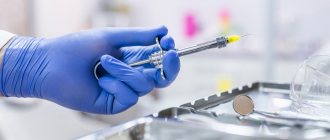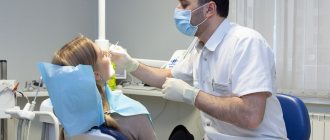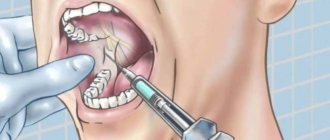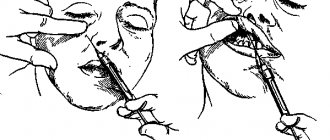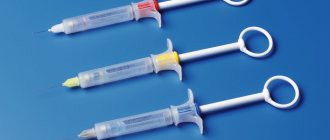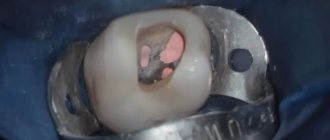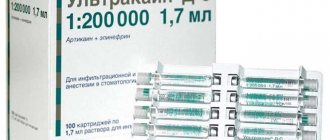Intrapulpal anesthesia allows you to quickly relieve pain using various methods. Most often, the drug is delivered to the affected area using a bur, but if necessary, the doctor can use the method of opening the caries hole and treating the surface. The drug is administered in a minimal amount, this is done gradually. When administered, the patient may feel pain, but it quickly passes and the effect lasts for several hours.
Description
Intrapulpal anesthesia is an additional type of anesthesia that is used in the treatment of pulpitis. The procedure involves injecting an anesthetic into the pulp area.
The manipulation is performed using a dental carpule syringe with a thin needle up to 1 cm. Such a needle makes it possible to adjust the angle of inclination. These are mandatory conditions for anatomical defects of the unit.
Most dentists prefer the injector brand IS - 01 - 1, domestically produced.
The composition of the drug is lidocaine 2% and derivatives.
For dental canals with low traffic, needle-free injectors are used.
Before the procedure, auxiliary blockade with histamines or analgesics is mandatory. The blockade is carried out 60 minutes before the treatment procedure.
Anesthesia in modern dentistry has long become a comfortable and completely painless procedure. After all, the doctor has everything to ensure that the patient does not feel anything except a little pressure during the appointment.
Anesthesia is divided into several types and stages. Types of local anesthesia
- Appliqué
- Infiltration
- Conductor
- Intrapulpar
- Intraligamentary
- Osteocentral
Application anesthesia
For initial targeted anesthesia, application anesthesia is used: the area around the tooth is smeared with gel on a sterile cotton swab, which gives the effect of slight numbness in the gum area in just 30 seconds, thanks to which the injection site becomes completely insensitive.
For all types of anesthesia, a carpule syringe and a carpule with an anesthetic, which has a small, hair-thin needle, are used. The anesthetic itself is administered very slowly, and sometimes even in portions, thereby not giving the patient any sensitivity other than a feeling of fullness.
Infiltration anesthesia
This anesthesia is most often performed for the treatment of teeth in the upper jaw, in the treatment of caries, tooth extraction, root canal treatment of a tooth, tooth root resection, frenuloplasty, gumplasty, implantation, sinus lift. Less often, on the lower jaw, only when necessary - during professional oral hygiene, periodontal cleaning and minor treatment of the front teeth. This type of anesthesia occurs very quickly, literally 3-5 minutes, and its effect lasts no more than 1.5 hours.
Conduction anesthesia
This anesthesia is performed only on the lower jaw, during the treatment of caries, pulpitis, and tooth extraction. It is not inserted into the area of intended treatment, but closer to the nerve responsible for this area of the jaw. With such anesthesia, half of the jaw, half of the tongue, half of the lower lip and the cheek on the side of which anesthesia was administered go numb. This type of anesthesia has a great advantage over infiltration anesthesia - during its onset, several teeth can be treated or removed at once. Such anesthesia does not occur immediately, but after 10-15 minutes, but its effect lasts up to 4 hours. During any anesthesia, the patient’s face does not change in any way, there are no asymmetric changes, these are just sensations. To make the anesthesia go away a little faster, after treatment it is recommended to drink warm tea or any other warm drink. Eating after general anesthesia is not recommended due to the high probability of injury to the cheek or lip, since they are practically insensitive.
Intrapulpal anesthesia
This type of anesthesia is performed when there is a lack of conduction or infiltration during the treatment of tooth canals. A very thin needle of 0.3 mm with a shortened bevel is used. It can be adapted (bent) to fit any cavity. In this case, anesthesia is administered directly into the pulp, where the nerve of the tooth is located.
Intraligamentary (intraligamentous) anesthesia
Intraligamentary anesthesia is administered into the periodontal ligament around the tooth. It is also added for infiltration and conduction anesthesia, if they are not enough. The duration of this anesthesia is 30-40 minutes. The anesthetic is administered very little and slowly. Typically, such anesthesia alone is not enough to treat or remove a tooth.
Osteocentral anesthesia
This anesthesia is administered directly into the bone using a special electronic device. You can numb up to 6 teeth completely painlessly with 1 injection. A huge advantage of this anesthesia is that you can forget about the fear of biting your lip - there will be no anemia. The tip of the device is controlled like a pen, which makes the procedure even more comfortable for the patient.
Modern anesthetics for local anesthesia in dentistry
Modern anesthetics are made on the basis of Articaine. It is superior to the outdated novocaine and lidocaine. Contained in anesthetics: Ubistezin, Ultracaine, Septonest. Many anesthetics also contain adrenaline and epinephrine; they help the anesthesia last longer by constricting blood vessels in the injection area.
Ultracain DS forte is most often used for conduction anesthesia.
Ultracaine DS is used for infiltration anesthesia, as well as for children, pregnant and lactating women and people with high blood pressure.
Ubestezin and Ubestezin-forte are used for conduction and infiltration anesthesia. Contains articaine and epinephrine.
Septanest - this anesthetic contains, in addition to articaine and epinephrine, adrenaline, therefore it is contraindicated in children, patients with tachycardia and anemia. But due to vasoconstriction in patients without contraindications, anesthesia with this anesthetic occurs much faster and its effect is longer.
Skandanest - this anesthetic is made on the basis of mepivacaine. It is used for conduction and infiltration anesthesia, in the treatment of caries, tooth extraction, etc. Has a fast and strong effect for up to four hours.
{jlcommentspro}
Operating principle
The composition is delivered to the destination area through a carious cavity or a hole drilled with a bur. The latter option is preferable, since the diameter of the hole will be equal to the needle. This will prevent the substance from leaking into your mouth.
There is pain when the composition is introduced. The dentist minimizes discomfort by applying a cotton swab with anesthetic or dripping the substance directly into the cavity from a needle.
The substance is administered slowly, with a volume of up to 0.3 ml. As the fluid penetrates inside, the doctor feels resistance. This indicates the correctness of the manipulation and the delivery of the medicine.
Since the immersion area is small, it is advisable to use a needle with a curved tip.
The effect occurs half a minute after the injection and lasts up to half an hour. The specified time is sufficient for dental intervention.
Intrapulpal anesthesia under pressure involves applying a cotton swab with dicaine or other anesthetic composition to the exposed areas of the pulp or the upper part of its arch. Then the cavity is sealed for a certain time.
This action is called “druk-anesthesia”. This is an application option, as a result of which the drug is absorbed by mucous membranes and bone tissue.
Some dental surgeons classify manipulation as an intraosseous method of pain relief.
What is intrapulpal anesthesia
The success rate of intrapulpal anesthesia reaches 95%. The effectiveness is immediate - after half a minute the patient stops feeling pain, although there is discomfort in the first moments. The drug is administered in a minimal dose - up to 0.3 milliliters, there is no negative effect on the body. The method is characterized as surface (application). The pain is relieved quickly; some dentists classify the procedure as an intraosseous method, since the drug quickly penetrates into the surrounding tissues.
Indications for use
The use of pain relief under pressure is only suitable for the treatment of early stages of pulpitis with carious lesions of teeth.
Anesthesia has the goal of relieving pain of varying intensity.
Application of the technique is shown:
- As a psychological impact on the client.
- In order to prevent an increase in pain.
- To prevent fainting due to the influence of the vagus nerve on the vascular system.
- For preparation of a cavity below the location of the filling in case of carious lesions in the middle part of the dental unit.
- When performing dental operations in case of superficial localization of the pulp.
The technique is prescribed for:
- deep carious lesions in acute form;
- open pulp horn;
- the need to form a cavity vault with further use of injection anesthesia.
Cons and pros
The list of advantages of using intrapulpal anesthesia includes:
- Delivery of medicine to the destination area.
- Instant results.
- No pain during dental procedures. After treatment, the pain impulse is slightly suppressed by the residual concentration of the drug in the tissues.
- Lack of resorptive effect.
It is also worth noting the disadvantages of the technology:
- Fear and psychological discomfort in the patient at the time of injection.
- Pain at the time of needle insertion or during perforation.
- Limited application of the technique due to the inaccessibility of individual areas.
- There is a possibility of intravascular penetration of the composition.
Features of tooth preparation
The technique of local anesthesia practically does not depend on the degree of progression and localization of the inflammatory process.
Algorithm for preparing for treatment:
- Clean the affected area from food debris and saliva.
- Smoothing the edges with a bur.
- Opening the working area.
- Removing the soft parts of dentin from the walls and base of the cavity.
- Treating the space with an antiseptic, drying.
After performing the above procedures, the dentist chooses the optimal method of anesthesia.
Tooth preparation
In order to choose the right method of anesthesia, it is necessary to carry out preliminary preparation of the tooth.
If during a visit to the doctor the patient experiences acute pain, the dentist immediately performs infiltration or conduction anesthesia to eliminate these sensations.
If at the time of the intervention the patient’s pain from inflammation has subsided, the dentist performs the following actions:
- Food debris is removed from the carious cavity.
- Using a dental bur, overhanging edges of hard tooth tissue are removed.
- The cavity with the affected area of the tooth is opened wide with the help of instruments so that the specialist has access to the localization of anesthesia.
- Using an excavator, softened dentin is removed from the bottom and side walls of the carious cavity.
- Remains of infected dentin are removed from the side walls using a sharp bur.
- The formed cavity is disinfected and dried with sterile cotton swabs and warm air.
Only after all these manipulations, based on the available data, does the dentist decide which method of anesthesia will be appropriate in a particular clinical case.
The main signs of initial pulpitis and the tactics of its treatment.
In this article we will talk about the features of treating dental cysts with depophoresis.
Read here about the effective treatment of dental phlegmon.
Contraindications to anesthesia in dentistry
Anesthesia in dentistry has some contraindications: allergic reactions to anesthetic components, individual intolerance. Side effects are mainly associated with the components of the solutions - vasoconstrictors, or vasoconstrictors, as well as stabilizers and preservatives. Therefore, the doctor is especially careful when choosing an anesthetic for patients with chronic diseases: endocrine, cardiovascular. Preference is given to drugs in which vasoconstrictor components are present in minimal quantities or are absent altogether.
To determine an allergic reaction, a preliminary examination by an allergist may be required. Based on the results of diagnosis and allergy testing, the specialist selects a safe local anesthetic. If reactions are observed to all local agents, general anesthesia may be used.
Possible complications and their prevention
As already noted, intrapulpal anesthesia should be performed only with sufficient access to the localization of the working space and a wide carious cavity. In addition, the possibility of anesthetic leakage should be excluded.
If this happens, the patient may develop an allergic reaction and damage to the mucosa.
If anesthesia is administered incorrectly, pulpal inflammation may occur, which leads to necrotization of the pulp. This entails removing the affected tissue or the entire pulp at once.
It is also possible to develop an allergic reaction if the patient is individually intolerant to the pain medication.
To avoid the development of complications when performing intrapulpal anesthesia, the instruments should be sterile and the patient’s medical history should be carefully collected.
Complications after intraligmentary anesthesia:
- Introducing an infectious agent into a bone socket - this happens if the dentist did not follow antiseptic measures or injected into an inflamed ligament;
- The development of inflammation of the gums or periodontium is possible if the treatment with an antiseptic before the injection was not carried out well enough;
- Gum death in the puncture area can occur if the needle was inserted incorrectly or the drug was delivered at an excessively high speed or the dose was too high.
You can make an appointment with CELT dentists online or by phone: +7 (495) 788‑33‑88. If you suffer from urolithiasis, contact the urology department of our clinic and undergo lithotripsy.
Make an appointment through the application or by calling +7 +7 We work every day:
- Monday—Friday: 8.00—20.00
- Saturday: 8.00–18.00
- Sunday is a day off
The nearest metro and MCC stations to the clinic:
- Highway of Enthusiasts or Perovo
- Partisan
- Enthusiast Highway
Driving directions
Preparations for local anesthesia
Local anesthetics are drugs from the group of neurotropic drugs that completely or partially block the flow of signals along nerve fibers from the site of painful manipulation or surgery to the central parts of the nervous system.
The peculiarity of the action of drugs is related to their spectrum of action. They suppress the transmission of signals along myelinated type A nerve fibers, which transmit feelings of pain, smell, and temperature. Tactile sensations are carried out through type B fibers, and anesthetics do not affect them. Therefore, when using local anesthesia, the patient does not feel pain, but feels the touch of the doctor and the surgical instrument.
Local anesthetic drugs are divided into 3 groups depending on the duration of action:
- short-acting - the effect lasts 30-50 minutes, these include Novocain;
- average duration - up to 90 minutes, these are drugs Lidocaine, Trimecaine, Ultracaine;
- long-acting – the effect lasts more than 90 minutes, typical for Bupivacaine.
Local anesthetic drugs affect the electrochemical processes of ion exchange in nerve endings. Medicines work effectively in an alkaline environment and tissues rich in lipids, which include nerves. But the analgesic effect decreases with severe tissue inflammation, which is associated with a transition of pH to the acidic side.
The effect of local anesthetics is enhanced by drugs that affect vascular tone. Therefore, they are often combined with adrenaline to prolong the effect. This allows you to reduce the dose of pain medication and avoid toxic reactions.
Useful tips
To ensure that the intervention on the pulp is painless, the specialist is recommended to adhere to the following tactics:
- when the anesthesia takes effect , you need to take a sterile bur No. 1 and open the tooth cavity with it at one point, best of all - in the area of the projection of the horn of the dental pulp;
- to minimize pain from vibration and temperature , it is recommended to use turbine drills with an air-water cooling system;
- in the case of using a surgical method , an additional tampon with an analgesic should be placed on the exposed horn, and after a couple of minutes intrapulpal anesthesia should be performed by inserting an injection needle into the created hole.
In addition to these recommendations, the doctor should adequately assess the current clinical situation. If there is a threat of anesthetic leakage during pressure anesthesia, then another method of anesthesia should be chosen.
Dentists' opinions
Many dentists refuse to perform anesthesia in favor of injection methods. As the main arguments, they cite patient discomfort during the procedure and the risk of side effects, in particular infection.
According to skeptics, infectious agents enter the wound along with the anesthetic. However, some other experts, on the contrary, are inclined to believe that this method is highly safe with proper preparation for the procedure.
Today, dentistry has a sufficient amount of sterile materials and antibacterial drugs to prevent infection.
Algorithm for administering intraligmentary anesthesia
Anesthesia is carried out according to the following protocol:
- The gums and teeth are treated with a disinfectant;
- The needle is inserted to a depth of one to two millimeters into the area between the gum and the crown, positioning it at an angle of 30° to the vertical axis of the tooth (this is how the periodontium is least injured);
- By pressing the plunger of the syringe for seven seconds, the dentist injects about 0.06 ml of anesthetic;
- Pressure is repeated two to three more times to inject about 0.12-0.18 ml for a single-rooted tooth (a molar will require a larger volume: 0.35-0.55 ml).
If, during the administration of anesthesia, the dentist detects drops leaking out from under the gums, the procedure is carried out incorrectly: the needle hole is clogged, the solution is injected too quickly or at the wrong angle. The fact that the drug was administered correctly is indicated by paleness of the gums around the affected tooth.
Advantages and disadvantages
For simple surgical interventions, local anesthesia is indispensable; it has advantages over other types of sensitivity suppression. The drug that is used, an anesthetic solution, acts strictly at the injection site, which helps to avoid severe complications and adverse reactions.
The blockade of pain sensitivity develops on average in 10-15 minutes. The effect lasts for an hour or more, so local anesthesia can reduce pain in the area of the postoperative wound. The patient’s consciousness does not suffer from the action of the local anesthetic, so after the manipulation he can leave the clinic and not be in the ward.
But local anesthesia has its drawbacks. Just a few years ago, it was widely used for operations on superficial tissues and extremities; methods for intravenous administration of drugs with simultaneous application of a tourniquet were developed. Intraosseous anesthesia was widely used. But due to the large number of adverse reactions and complications, these methods began to be used less frequently. And after receiving high-quality drugs for anesthesia, dangerous methods of pain relief were practically abandoned.
The disadvantage of the local method is its limited scope of application. It is effective for anesthesia of mucous membranes, skin and superficial tissues, but is not used for operations on the abdominal and pelvic organs, neck and head.
The infiltration type of local anesthesia cannot be used when operating on malignant tumors due to the possibility of tumor cells entering beyond the wound into other tissues. This increases the risk of developing metastases.
Reviews
If you want to share information about intrapulpal anesthesia from the dentist’s or patient’s perspective, leave your comment under this article so that users of our portal can form a more complete opinion about this procedure.
If you find an error, please select a piece of text and press Ctrl+Enter.
Tags: anesthesia, toothache
Did you like the article? stay tuned
No comments yet
